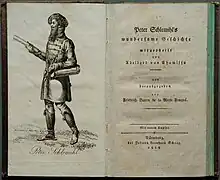Schlemiel (Yiddish: שלומיאל; sometimes spelled shlemiel or shlumiel) is a Yiddish term meaning "inept/incompetent person" or "fool".[1] It is a common archetype in Jewish humor, and so-called "schlemiel jokes" depict the schlemiel falling into unfortunate situations.[2]
Meaning
The inept schlemiel is often presented alongside the unlucky schlimazel. A Yiddish saying explains that "a schlemiel is somebody who often spills his soup and a schlimazel is the person it lands on".[3] The schlemiel is similar to the schmuck but, as stated in a 2010 essay in The Forward, a schmuck can improve himself while "a schlemiel, a schlimazel and a schmendrik are irredeemably what they are".[4]
The etymology of the term is unsure. Ernest Klein in his Etymological Dictionary of the Hebrew Language suggests that the word comes from the Hebrew term shelo mo'il, meaning "useless".[5] Another theory is that the word is derived from the name Shelumiel, an Israelite chieftain.[6]

Heyse and some other etymologists suggest that the name comes from the words "shlomi" + "el" in the meaning "God is my salvation", i.e., a Schlemiel hopes that God will save him.[7]
The term was popularized by the name of Peter Schlemihl, the main character of a 19th century novella by Adelbert von Chamisso.[7]
According to Harvard University literature professor Ruth Wisse, the schlemiel as a type emerges in the Yiddish literature of the period of Jewish emancipation.[8]
In culture
- An archetype shlemiel entrepreneur is Menahem-Mendl of Sholem Aleichem.
- In a 1944 essay, Hannah Arendt argues that Charlie Chaplin's Tramp character is a schlemiel whose only comfort is "the kindness and humanity of casual acquaintances".[9]
- Many of Woody Allen's films feature Allen portraying a schlemiel type, particularly in his relations with women.[10]
- Larry David's character on the HBO series Curb Your Enthusiasm serves as a modern schlemiel, encountering "problems that affect contemporary middle- to upper-class American Jews".[11]
- In the sitcom Seinfeld, George Costanza "follows the pattern of the classic schlemiel", with Jerry Seinfeld's character serving as his schlimazel.[12]
- The 1995 Israeli-European animated feature The Real Shlemiel centers on a village of schlemiels, with its rabbi even taking it as a given name.
- Software engineer Joel Spolsky coined the term Schlemiel the Painter's algorithm in 2001, based on a Yiddish joke, to describe a certain type of inefficient software method.
- The titular character of the 2004 comedy film Napoleon Dynamite embodies the traits of the schlemiel, according to researcher David Buchbinder.[13]
- In the drama series The O.C. (2003–2007), Seth Cohen's personality "is self-deprecating and in line with that of past schlemiels".[14]
- In the 2009 film A Serious Man directed by the Coen brothers, the character of Larry Gopnik is depicted as a schlemiel.[15][16]
- In "Park Safety", a 2010 episode of the NBC sitcom Parks and Recreation, Ron Swanson states that his clumsy coworker Jerry "is both the schlemiel and the schlimazel".[17]
- In Thomas Pynchon's novel V., the protagonist Benny Profane is identified as a schlemiel numerous times.
See also
References
- ↑ Harkavy, Alexander (1925). Yidish-English-Hebreyisher Verterbukh (in Yiddish). New York City: Alexander Harkavy.
- ↑ "Schlemiel Jokes | My Jewish Learning". My Jewish Learning. Retrieved 2017-11-17.
- ↑ Kibrick, Barry (2015-11-09). "Schlemiel! Schlimazel! Hasenpfeffer Incorporated!". Huffington Post. Retrieved 2017-11-17.
- ↑ "Etiquette for Schmucks, Schlemiels, Schlimazels and Schmendriks". The Forward. Retrieved 2017-11-17.
- ↑ "shlemiel". www.balashon.com. Retrieved 2017-11-17.
- ↑ "Shelumiel – The First Schlemiel?". The Forward. Retrieved 2017-11-17.
- 1 2 Zeldner, Max (1953). "A Note on "Schlemiel"". The German Quarterly. 26 (2): 115–117. doi:10.2307/401795. JSTOR 401795.
- ↑ The Shlemiel as a Modern Hero, by Ruth Wisse, University of Chicago Press, 1971. Review: Avni, Abraham. Comparative Literature, vol. 25, no. 4, 1973, pp. 361–363. JSTOR 1769513
- ↑ Arendt, Hannah (1944). "The Jew as Pariah: A Hidden Tradition". Jewish Social Studies. 6 (2): 99–122. JSTOR 4464588.
- ↑ Feuer, Menachem (2013). "The Schlemiel in Woody Allen's Later Films". In Bailey, Peter; Girgus, Sam (eds.). A Companion to Woody Allen. John Wiley & Sons, Inc. pp. 403–423. doi:10.1002/9781118514870.ch19. ISBN 9781118514870.
- ↑ Gillota, David (2010-11-22). "Negotiating Jewishness: Curb Your Enthusiasm and the Schlemiel Tradition". Journal of Popular Film & Television. 38 (4): 152–161. doi:10.1080/01956051003725244. ISSN 0195-6051. S2CID 143932889.
- ↑ Johnson, Carla (1994-07-01). "The Schlemiel and the Schlimazl in Seinfeld". Journal of Popular Film & Television. 22 (3): 116–124. doi:10.1080/01956051.1994.9943676. ISSN 0195-6051.
- ↑ Buchbinder, David (Summer 2008). "Enter the Schlemiel: the emergence of inadequate or incompetent masculinities in recent film and television". Canadian Review of American Studies. 38 (2): 227–245. doi:10.3138/cras.38.2.227. S2CID 163138459.
- ↑ Olson, Tamara. "Popular Representations of Jewish Identity on TV: The Case of The O.C.". Digital Commons at Macalester College.
- ↑ Denby, David (2009-09-28). "Gods And Victims". The New Yorker. ISSN 0028-792X. Retrieved 2017-11-17.
- ↑ "J. Hoberman Reviews the Coen Brothers' 'Inside Llewyn Davis'". Tablet Magazine. Retrieved 2017-11-17.
- ↑ Garber, Megan. "The Downtrodden Jerry Gergich Is the True Hero of Parks and Recreation". The Atlantic. Retrieved 2017-11-17.